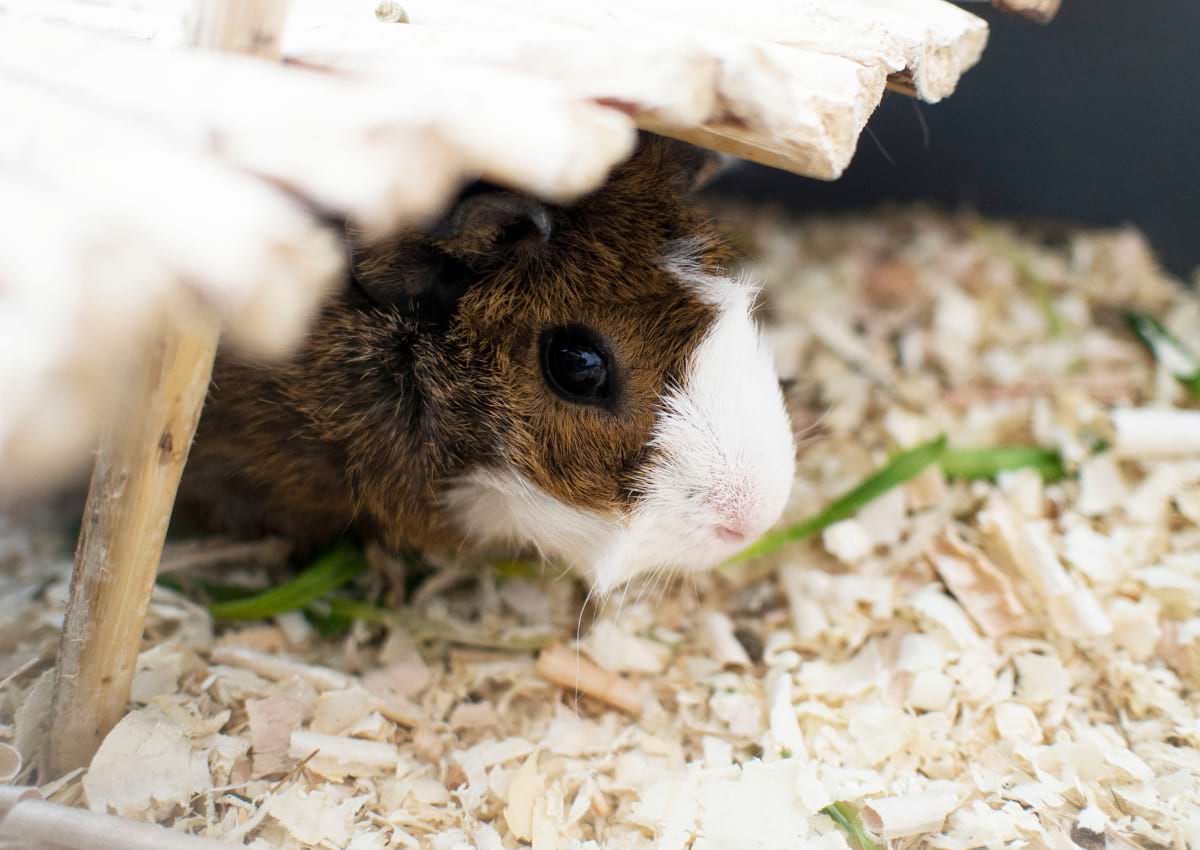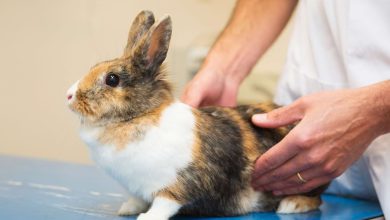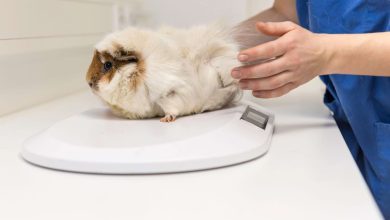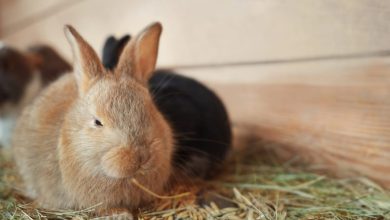15 Common Health Issues in Guinea Pigs

Many common health issues in guinea pigs are a result of poor diet or unsanitary conditions, such as scurvy, bumblefoot, and more. They’re also very prone to respiratory diseases and gastrointestinal problems, which can be fatal if left untreated.
Illnesses can progress quickly in guinea pigs, so it’s important to educate yourself on their common health issues and symptoms to watch out for. In this article, we’ll go over 15 common health concerns in guinea pigs, their symptoms, treatments, and more.
Upper Respiratory Infections
Upper respiratory infections (URIs) are one of the most common ailments in guinea pigs. Their respiratory systems are sensitive, and illness can be triggered by scented cleaning products (including laundry detergent), other fragrance items such as candles, and dusty materials such as bedding.
While you should avoid these items, even piggies in perfect environments can develop respiratory infections. Symptoms include:
- Sneezing
- Reduced appetite
- Weight loss
- Discharge from the eyes or nose
- Labored breathing
Respiratory infections can be deadly, especially if they develop into pneumonia. Please schedule a vet appointment immediately if you notice symptoms.
Pneumonia

Pnuemonia is another respiratory illness that often progresses from a URI. It can be caused by a number of bacteria including Staphylococcus, Streptococcus, and Bordetella,
Respiratory disease in guinea pigs can progress incredibly fast and it’s important to seek veterinary help immediately.
Ear Infections
Ear infections are another common, but typically less severe, health issue in guinea pigs. Symptoms include:
- Reduced appetite
- Weight loss
- Head tilt
- Walking in circles
- Ear discharge
- Itching
- Labored breathing
- Deafness
Often there are no symptoms that point toward an ear infection, such as the redness and itching we commonly see in dogs. Your guinea pig may simply have a reduced appetite and lose weight. Head tilts are common in piggies with ear infections, but they can have an infection without a head tilt as well.
Anytime your guinea pig’s appetite or behavior changes, they should see a veterinarian. Your vet will likely use radiographs to see the inner ear if they do suspect an infection.
While ear infections aren’t usually emergencies, they must be treated by a professional to prevent the infection from spreading further into the body. If your guinea pig is having trouble breathing, see a vet immediately.
Gastrointestinal (GI) Stasis
Gastrointestinal (GI) stasis is a deadly condition where a guinea pig’s gut slows or stops processing food. A guinea pig can go into GI stasis after just 6-8 hours without food, especially if they’re also without water.
Remember that guinea pigs must have constant access to fresh hay and water without exception, as they need to be eating constantly to keep their metabolism functioning.
If your guinea pig stops eating, schedule an emergency appointment with your veterinarian–for the same day if possible. In the meantime, you can ask about feeding Critical Care to keep their gut moving.
Symptoms of GI stasis include:
- Reduced appetite
- Weight loss
- Pooping less or not at all
- Teeth grinding
- Abdominal pain or swelling
- Dehydration
Dental Problems

Guinea pigs are prone to a plethora of dental problems, including overgrown teeth, broken teeth, mouth ulcers, and more.
Dental issues can lead a guinea pig to eat less, to only eat soft foods such as veggies, or to stop eating entirely. This leads to weight loss and often, eventually, to GI stasis.
It’s important to monitor your guinea pigs’ teeth and weight through regular health checks. If you notice any weight loss, tooth overgrowth, damage, misalignment, or other dental issues, schedule an appointment with your veterinarian.
Sometimes, a poor appetite or weight loss are the only visible symptoms of dental disease. Your veterinarian may need to perform x-rays to diagnose your piggy, especially if the back teeth or the roots of the teeth are impacted.
Scurvy
Like humans, guinea pigs don’t produce their own vitamin C. They get it in their diet through their pellets and daily vegetables. It’s important to feed a mixture of dark, leafy greens so that your piggies get all the nutrients they need.
Vitamin C supplements are okay to give in addition to a healthy diet so long as they’re given correctly. For instance, some people like to give Child Life liquid vitamin C directly to their guinea pigs with a syringe or feed them Oxbow’s vitamin C treats.
Droplets put into the water aren’t acceptable as vitamin C quickly disintegrates in sunlight, and these drops often put guinea pigs off their water.
If your guinea pig doesn’t get enough vitamin C, they may show symptoms of scurvy such as:
- Weight loss
- Lethargy
- Joint pain and swelling
- Whimpering or other painful sounds
- Dental issues
- Teeth grinding
- Bruising
- Red spots on the gums
- Diarrhea or soft stool
- Rough, dull coat
Bumblefoot

Bumblefoot is also known by a few other names including pododermatitis and sore hocks.
Bumblefoot is an injury to the foot that can be caused by being kept in a cage with an unpadded grid bottom, bedding that’s painful on the feet, nonabsorbent bedding that leaves guinea pigs standing in urine, and not cleaning the cage frequently enough. While bumblefoot is often caused by poor care, this isn’t always the case.
Symptoms include:
- Redness or sores on the feet, especially the heel
- Pain
- Swelling
- Bleeding
- Fur loss on the feet
- Reduced activity levels
- Infections of the foot, especially if sores are left untreated
If left untreated, bumblefoot can eventually lead your guinea pig to stop moving due to pain. They might not eat or drink. Their wounds may smell bad due to infection, they may develop ulcers on their feet, and you may notice discharge coming from the wounds.
In severe cases where infection reaches the bone and tissue, your guinea pig may become paralyzed.
While early-stage bumblefoot isn’t life-threatening, letting the problem persist can lead to a piggy needing amputation, dying from infection or GI stasis, or having such reduced quality of life that euthanasia is recommended. This is why it’s so important to treat it early!
Parasites and Fungal Infections
Common parasites and fungal infections in guinea pigs include ringworm, mites, and lice. These are more likely if your guinea pigs are kept outdoors, aren’t on parasite-prevention medication, or their cage isn’t cleaned regularly.
However, they can also get mites and lice from hay or other infested materials. Ringworm is common and very contagious, so your piggies may develop it after you introduce them to a newly-adopted piggy.
Mites cause intense itching and hair loss and are invisible to the naked eye, though you might see what looks like dust in the fur. This is actually the mites’ shedded skin.
Lice look like small specks on the coat or skin and typically congregate around the neck and ears. They can cause itching, restlessness, blood loss, anemia, weakness, and swelling around the neck and ears. Lice infestations tend to flare up when guinea pigs are stressed.
Lastly, ringworm is a fungal infection that causes fur loss and patches of dry, crusty skin. It can also cause redness, swelling, a rough coat, and itchiness.
While lice and mites are typically species-specific, and thus cannot be passed onto humans, we can catch ringworm from our piggies. Handle them carefully if they have it, wash your hands well, and see a doctor yourself if necessary.
Osteoarthritis
Arthritis is common in senior guinea pigs and can cause symptoms such as pain, stiff joints, lethargy, wobbling, and doing less climbing, jumping, and standing on the hind legs.
If your guinea pig appears to be in pain, your veterinarian may prescribe pain medication to keep them more comfortable throughout their senior years.
Heat Stroke
Heatstroke is when a guinea pig overheats. It’s most common in guinea pigs housed outdoors, but it can happen inside too, especially if you don’t have air conditioning in the summer.
The outside temperatures lead to a rise in a piggy’s body temperature, which leads to increased heart and respiratory (breathing) rates. You may find your guinea pig lying on their side, breathing rapidly.
Heatstroke is a medical emergency and can be deadly. Once a guinea pig is affected, trying to cool them down too quickly can also be dangerous–so please don’t use ice or submerge them in cold water. It’s best to call your nearest exotic or emergency vet clinic and follow their instructions.
To prevent heatstroke, keep your guinea pigs in a temperature-controlled indoor space. Some people who keep them outdoors think providing shade is enough, but this often isn’t true.
Bladder Stones
Bladder stones are typically made of excess minerals that cause blockages in guinea pigs’ urinary tracts. Sometimes this occurs because their diet is too rich in calcium. This may include drinking hard tap water, so some people prefer to give their piggies bottled or filtered water instead.
Some bladder stones can be passed on their own, though the condition can still be painful. Larger stones require surgical removal. Addressing the cause of the stones is also important so that they don’t reoccur.
Symptoms of bladder stones include pain or difficulty urinating, bloody urine, and less urine in the cage. In severe cases, a guinea pig’s bladder may rupture or their kidneys may become damaged. Bladder stones can lead to death, so please see your veterinarian quickly if you spot any symptoms.
Urinary Tract Infections

Urinary tract infections (UTIs) have similar symptoms to bladder stones, including bloody urine and pain while urinating.
Keeping your guinea pigs’ cage clean is an important part of preventing UTIs. Since they have short little legs, their bodies are close to the ground–and it doesn’t help that they like to poo and pee where they sleep!
Your vet will typically treat a UTI with antibiotics, though you may need to try different medicines since these infections can be resistent to treatment. Once a guinea pig gets a UTI, recurrence is fairly common, so be sure to watch out for infections in the future as well.
Ovarian Cysts
Ovarian cysts cause crusty nipples, a pear-shaped body, and hair loss on your guinea pig’s sides, or flanks, You might notice increased aggression or dominance in your guinea pig as well.
Ovarian cysts are a common cause of death in intact female piggies. They can sometimes be treated through spaying your piggy, though veterinarians and piggy guardians will have different perspectives on whether this is worthwhile due to the risk of putting guinea pigs, especially seniors, under anesthesia.
Other treatments may include hormone injections or draining the cysts, though neither of these is curative.
If you suspect your guinea pig has ovarian cysts, talk to your veterinarian about your treatment options. They can give advice on whether spaying is a good option based on your guinea pig’s age, health, and other risk factors.
Pregnancy Complications
Guinea pigs over the age of six to eight months tend to have an incredibly difficult time with first pregnancies. This is because their pelvis fuses in a way that makes giving birth difficult to impossible for their bodies to handle.
It’s always important to get vet care for a pregnant guinea pig and her babies, but it’s absolutely vital if she’s over six months and hasn’t had a former pregnancy (or if you’re unsure whether or not she’s given birth before). Your veterinarian will likely recommend a scheduled C-section.
This may seem excessive or too costly, but it isn’t optional. The alternative is often the loss of both the mother and her babies.
Tumors
Lastly, both benign and cancerous tumors can occur in guinea pigs. Some of these you’ll be able to see clearly, such as tumors on the surface of the skin, while others may form inside of the body.
Symptoms vary, and you may not know that your guinea pig has a tumor unless you can see it or your veterinarian finds it on radiographs. Some piggies will live normal lifespans with benign tumors, while other tumors may indicate aggressive cancers that kill quickly.
If you notice any lumps, bumps, or other symptoms, schedule an appointment with your veterinarian. They can advise you on your next steps, which may include biopsies, radiographs, or other diagnostics.
I hope you’ve been able to learn more about guinea pig health and common ailments to watch for. Remember not to panic if your guinea pig shows symptoms of illness, but do book a vet appointment as soon as you can!



